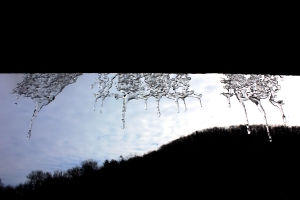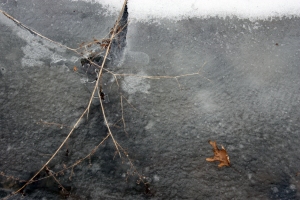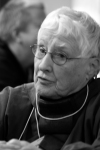Tōnen O’Connor
In his Commentary on the Song of Awakening, Kōdō Sawaki utilizes the poem by Yung-chia Hsuan-chueh, a 7th century Chinese Chan monk known in Japanese as Yoka Genkaku as a platform to express his wide understanding of the teachings of the Buddha. Toward the end of the book he coins a phrase to describe our usual human situation: “the world below zero. ” Here he is speaking of 0 degrees Centigrade or 32 degrees Fahrenheit, i.e. the point at which water freezes. He says:
“When I recently traveled to Manchuria, I coined a phrase suitable to Manchuria: “below zero”. It became pretty popular. It’s also apparent that the world of zero isn’t limited to Manchuria. Within the world below zero we find innumerable specimens: the rich, the powerful, and leading figures in the university or in society. Man must absolutely pass beyond this world of zero.” 1
What is this world of zero in which he says most of us exist? It is the ice of our illusions and our desires, the frozen expanse of our misunderstandings, in which we are trapped. The open water of the world into which we were born has gradually frozen into rigid delusions about how things actually are. Little by little, our opinions, our ideas, our viewpoint have congealed until we are trapped within them.
These rigid and frozen understandings impede the freely flowing river of impermanence. We wish to grasp things and situations by “knowing,” by freezing them into something solid that we can control, either literally or mentally. I don’t know about you, but I’m always uneasy when someone says , “Oh, I’ve heard all about you!” for they are trying to freeze me into their image of me. And sometimes we can “know” too much, holding back free flowing reality behind the self-constructed dam of our assumptions. Dōgen Zenji refers to this in one of the evening dharma discourses that he gave to his monks on the topic of knowing or not knowing.2 Dōgen describes a Zen dialogue on the problem of knowing and then: After a pause, Dōgen said: “If the great ocean knew it was full, the hundreds of rivers would all flow upstream.” 2 If it thought, if it “knew” that there was no more room, the great ocean would slam shut its gates to the rivers of the world. Fortunately for our world, the ocean does not “know,” does not think of empty or full and generously receives all the rivers that flow into it. But trapped in our frozen concepts, we in the world below zero shut ourselves off from possibilities, seeing only the world distorted and restricted by our illusions., by what we “know.”
 I’d like to interject here an idea of my own concerning an additional metaphor that we might use when we think of “the world below zero.” Within our concept of mathematics, zero marks the dividing line between plus and minus. The world below zero is the minus world, the world in which we are hemmed in by what cannot be done, by a very narrow range of possibilities. When we leap over zero. we enter the plus world, a world filled with a vast range of possibilities. So whether we live in a world of frozen concepts or a world lacking possibility, we must find a way to leap beyond zero.
I’d like to interject here an idea of my own concerning an additional metaphor that we might use when we think of “the world below zero.” Within our concept of mathematics, zero marks the dividing line between plus and minus. The world below zero is the minus world, the world in which we are hemmed in by what cannot be done, by a very narrow range of possibilities. When we leap over zero. we enter the plus world, a world filled with a vast range of possibilities. So whether we live in a world of frozen concepts or a world lacking possibility, we must find a way to leap beyond zero.
Kōdō Sawaki insists that we free ourselves, that we leap free of the ice of our illusions so that the rivers may flow into the ocean. He says, in these excerpted statements, which I have chosen to link together:
“We must leap over the barrier of zero……….That which is beyond zero has no name —it is the truth. This thing without name that we call true reality must be sought after…….everything found below zero is in the realm of the dream. …… The ultimate end of Buddha’s teaching is to make men leap over the barrier of zero, were it only once. This is truly the “great business” of Buddhism.
When we go beyond zero, there is no delusion to avoid and no satori to seek after.,,……When a person goes beyond zero, he is great, even if a janitor. This is what “the self is itself Buddha” (sokushin sobutsu) means: then all things are equal.”
A key phase in this is “then all things are equal.” Within our everyday understanding, all things are NOT equal; they differ in size, shape, purpose, mode of being, value to us. But once we rise above zero, we understand that all things have equal weight within emptiness, for all are equally a component of the continual interaction of impermanence and interdependence that creates ever-changing life. All are equal participants in the endless process. Although we live day to day in the world of dualism in which we must perceive things as separate and distinct, our understanding of their ultimate equality within the process of emptiness may help us be more flexible in our responses and our judgments.
 In Busshō, (Buddha Nature) as translated by Abe and Waddell, Dōgen says, “..the roots, stem, branches, twigs, and leaves are each equally the Buddha-nature – living the same life, and dying the same death as the same entire being.” 3 Sawaki echoes this: “When we comprehend the essence of the universe, we understand that living beings, plants, minerals, absolutely everything in the universe has buddha nature and it’s good thus.”
In Busshō, (Buddha Nature) as translated by Abe and Waddell, Dōgen says, “..the roots, stem, branches, twigs, and leaves are each equally the Buddha-nature – living the same life, and dying the same death as the same entire being.” 3 Sawaki echoes this: “When we comprehend the essence of the universe, we understand that living beings, plants, minerals, absolutely everything in the universe has buddha nature and it’s good thus.”
It is this understanding that Sawaki Rōshi sees as available to us if we go beyond zero and he urges us to do so.
“The Buddha Dharma is the sphere of the absolute highest degree. Dim and dense minds situated below zero are blind to the Buddha and the Dharma. If they were to glimpse it, if only for a moment, they would be astonished at having lived up until then at ten thousand degrees below zero, and would say to themselves, “How have I been able to not only pass through zero, but go beyond?” For with a leap, in an instant, they find themselves at the absolute highest degree.”
What is this leap, this going beyond in an instant? As Zen practitioners, we realize that our practice of zazen opens up a remarkable path to recognizing our illusions and letting them go. In zazen, we get a taste of how it is to be freed from our thoughts: though they crowd in, we do not have to pay attention to them. Still, all too often as soon as we rise from zazen we are once again the prisoner of our dualistic viewpoint, endlessly sorting what we like and what we dislike. How can we cast off our illusions and awaken to the world beyond zero? Sawaki Rōshi reminds us that:
“Illusion and awakening do not have different natures. We must grasp the origin of that which so completely blinds our self that we see dualism where none exists.”
For we human beings, our dualistic viewpoint is deeply necessary – an ability to discriminate, to isolate, to categorize, that allows us to organize our reality and function in our every day lives. Yet this very gift also blocks our glimpse of a world without dualism in which all things exist as equal in value, in which no judgments exist. We make a perilous mistake if we attempt to eliminate this dualistic consciousness, for it is our defense against chaos. Yet at the same time it this consciousness that is the cold current that continually attempts to freeze everything into a permanently recognizable state and which can thus create a rigid and inflexible self unable to break through the ice of the world below zero. And some times we are too comfortable in our world below zero, fearing the breakup of the illusory solidity of our attainments, of what we know. At this point it is useful to remember the Heart Sutra, the Hannya Shingyo, which tells us there is “nothing to attain and with nothing to attain the mind is no hindrance. Without hindrance, no fears exist.”
 Let us turn to Sawaki Rōshi again: “We must become conscious within our most profound depths that our body, as it is, is one with our mind and that it is identical with the essence of the universe. To discover the ultimate reality that constitutes the grandeur of our life and consecrate all our efforts to it. we must find it within the nature of our ignorance and our empty and illusory body.”
Let us turn to Sawaki Rōshi again: “We must become conscious within our most profound depths that our body, as it is, is one with our mind and that it is identical with the essence of the universe. To discover the ultimate reality that constitutes the grandeur of our life and consecrate all our efforts to it. we must find it within the nature of our ignorance and our empty and illusory body.”
We must have courage and conduct our search for true reality within our own delusions. When we see them for what they are, we begin to awaken to an open world beyond comparisons and judgments, beyond dualism. We are urged to expand our vision, to make it as wide as the universe. Sawaki continues:
‘The aim of the practice of Buddhism is to make us discover true reality. It immediately awakens a pressing need to know what it’s like. Now, the true character of reality has but one characteristic: an absence of character. It’s neither this nor that. All existence in the universe, all phenomena without exception are the true nature of reality. It is said in the Hannya Shingyo: “All dharmas are marked by emptiness; they neither arise nor cease, are neither defiled nor pure, neither increase nor decrease.” Such is the true nature of reality: without beauty, without filth, without birth, without death. We must then comprehend true reality……To discover the nature of reality is to embrace the panorama of the universe in a single glance. When we have vision like this, we have comprehended the teaching of Buddha.
It’s not necessary to use a telescope or bend over a microscope to contemplate the spectacle of the universe. There’s no need to take so much trouble. It’s sufficient to refuse to perceive all the illusions that blind us.
We do not embrace the universe with a single glance and so we weep and we laugh. When our vision is total there’s neither attraction nor repulsion: things are simply what they are, that’s all. This is only this; that is only that.’”
We are urged to open wide our eyes, to look beyond the prison walls of self. we are urged not merely to observe, but to embrace. This embrace is the leap beyond zero, out into the fluid, moving, changing universe, a universe we can enter without fear because we, too, participate.
It’s a matter of going onward in the realization that it is the activity, the energy, of today that creates tomorrow. And the nature of that tomorrow depends upon the fullness with which we have participated in today.
In the 7th century a Chinese monk wrote a poem to tell us how to make the leap to awakening:
“Do not calculate the vastness of the sky by peering at it through a straw.”
Notes:
1. All Sawaki quotes are from Commentary on the Song of Awakening, by Kodo Sawaki, translated from Japanese to French by Janine Coursin and from French to English by Tōnen O’Connor, MerwinAsia 2015
2. Dōgen’s Extensive Record, a translation of the Eihei Koroku, by Taigen Dan Leighton and Shōhaku Okumura, Wisdom Publictions, 2004
3. The Heart of Dōgen’s Shōbōgenzō, translated by Norman Waddell and Masao Abe, State University of New York Press, 2002
Tōnen O’Connor

Tōnen s the Resident Priest Emerita of the Milwaukee Zen Center, ordained in 1994, receiving dharma transmission in 1999 from Tozen Akiyama, and performing zuise at Eiheiji and Sojiji in 2000. She coordinates the MZC’s prison program serving over 160 inmates in 14 state institutions. She is active in Milwaukee with the Committee for Interfaith Understanding and the Buddhist Peace Fellowship, as well as currently serving on the Board of the Sanshin Zen Community in Bloomington, IN
